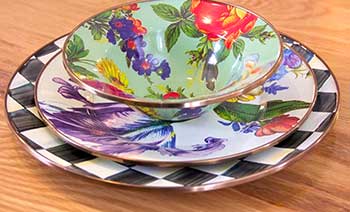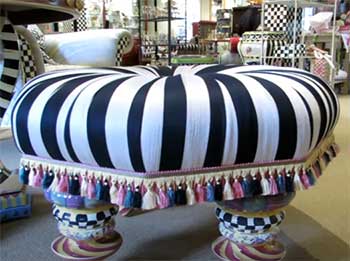Known for its whimsical checkerboard patterns and hand-painted motifs, MacKenzie-Childs is one of the most recognizable names in high-end home décor.
But with four-figure price tags routine for the brand’s ceramics, furniture, and accessories, MacKenzie-Childs resides firmly in luxury territory, far outpacing everyday home brands.
So what exactly accounts for the staggering prices on these ornamental home goods?
MacKenzie-Childs’ elevated costs ultimately come down to a combination of deliberate strategic choices by the company itself and the intrinsic qualities of its products. Examining both the business practices and the actual items reveals the keys to this boutique brand’s premium pricing.
Reasons For Mackenzie-Childs Being So Expensive
Here is a list of these reasons:
- Artisanal Production Methods
- Raw Materials Matter
- Intentional Scarcity
- Brand Allure
- Segmented Distribution
- Domestic Manufacturing
- Unique Marketing
- Customer Service
Here is a in-depth analysis of these reasons.
- Artisanal Production Methods

At the core of MacKenzie-Childs’ high prices is the meticulous handcrafting involved in creating each individual piece. Most brands rely on factory assembly lines churning out cookie-cutter products built for efficiency and affordability.
MacKenzie-Childs goes the opposite direction through artisanal production methods valuing quality and individuality over efficiency.
Every single item receives hand-painted accents, decals, ceramic glazing, and other detailing applied by skilled artisans rather than by machine. The result is subtle variations that make each MacKenzie-Childs piece unique.
Even when producing multiples of the same design, no two end up exactly alike due to the handmade process.
This personal touch comes at a cost. Artisanal production is far more time and labor intensive compared to mechanized manufacturing. But the handmade quality is also the reason MacKenzie-Childs resonates as authentic and valuable rather than mass-produced.
That meticulous craftsmanship explains how a $200 ceramic vase from MacKenzie-Childs can seem reasonable while a $20 vase from Target appears overpriced.
Beyond the production methods, the actual process of designing new pieces also moves slowly, with artists exploring ideas rather than churning out countless derivative designs.
MacKenzie-Childs introduces just a few dozen new items per year compared to the hundreds or even thousands coming from fast furniture retailers. This commitment to creativity over quantity further restricts output and availability.
- Raw Materials Matter
In line with the handcrafted ethos, MacKenzie-Childs uses high-end raw materials well beyond what is necessary strictly for functionality. Ceramics utilize fine glazed stoneware rather than basic earthenware prone to chips and cracks.
Furniture and larger accessories incorporate solid wood frames, brass or ceramic hardware, and lush upholstered fabrics.
While this elevates quality and durability, the premium materials also drive up base costs significantly before even accounting for the artisanal painting and detailing done by hand later.
Again, MacKenzie-Childs favors excellence in materials over cash savings in production.
The brand further invests in luxe packaging like silk-lined boxes for smaller items and thick woven blankets to swaddle dishware sets. Unboxing itself becomes an experience reflecting the craftsmanship. Even disposable packaging feels designed to last.
- Intentional Scarcity

Rather than flooding the market, MacKenzie-Childs creates intentional scarcity by producing most designs for limited runs before retiring them permanently.
New styles drop only a few times per year, ideally leaving demand unsatisfied.
This strategic constraint positions the brand as exclusive and discourages bargain shoppers from entering the mix.
Knowing pieces are not replenished or replaced annually also motivates buyers to pay more for available items. No one wants to regret missing out. Limited availability counters the set-it-and-forget mass production system that needs huge output volumes and cheap prices to turn profit.
Secondary market prices demonstrate this scarcity premium, with retired MacKenzie-Childs pieces often selling for 200-300% above original retail on resale sites. Low supply against steady demand enables these staggering markups.
Limited availability forces prices higher over time rather than lower.
- Brand Allure
MacKenzie-Childs invests heavily in building an aspirational brand image going well beyond the functionality of its products. Sponsoring celebrity-filled events like the Kennedy Center Honors and cultivating elite influencer tie-ups attracts press and cements its reputation as a premium lifestyle label.
The brand’s quaint boutiques with meticulous room vignettes further elevate the shopping experience from a basic retail transaction to an immersive luxury activity. This brand aura around MacKenzie-Childs appeals to affluent consumers’ emotions rather than just functional needs, enabling higher pricing.
Many buyers fall in love with the charming, whimsical MacKenzie-Childs aesthetic first and only later consider where it fits within their home and budget. Strong brand affinity allows the company to price based on desire rather than just manufacturing costs and margins.
- Segmented Distribution
MacKenzie-Childs scrupulously controls brand distribution, selling only through its own boutiques and smaller specialty shops rather than mass retailers.
This exclusive availability adds a feeling of unveiling secret treasures compared to walking the aisles at Target or Walmart. Consumers pay extra to access goods with perceived scarcity.
Avoiding department stores and big box retailers also allows MacKenzie-Childs to avoid margin-crushing discounts and inventory liquidations required for high-volume sales.
Exclusive distribution sustains desirability rather than eroding brand equity over time by trading down. Presentation within boutiques further elevates perception of the goods.
- Domestic Manufacturing

At a time when almost all home goods production has shifted overseas, MacKenzie-Childs maintains its manufacturing base in the United States.
Their headquarters and ceramic artisans remain centralized in upstate New York rather than outsourcing to Asia or elsewhere.
This domestic production allows tighter quality control and enables the brand’s creative direction. But American-based manufacturing results in significantly higher labor and materials costs compared to the economies of scale possible overseas.
MacKenzie-Childs essentially absorbs higher production expenses to deliver on quality.
Made in America also attracts buyers favoring domestic production and wanting to support local craftsmanship. For this audience, paying more for an American-made product actually increases its perceived value. Offshoring could lower retail prices but erode brand prestige.
- Unique Marketing
Rather than just social media ads or basic email promotions, MacKenzie-Childs invests in experiential marketing events that immerse consumers within the brand vision while generating press and social buzz.
The annual Warehouse Sale sees thousands line up for access to limited product and generate viral interest.
Partnerships with major events like the Kennedy Center Honors and high-end influencers build elite brand associations that reach wealthy demographics. For MacKenzie-Childs, marketing delivers an experience beyond hyping products.
This drives demand for the lifestyle embodied by the brand’s aesthetic even at luxury price points.
- Customer Service
MacKenzie-Childs invests heavily in customer service, anticipating and answering buyer questions to remove friction from its high-end sales process. Shopping for expensive discretionary home goods brings risk, uncertainty, and need for trust that exceeds a basic Walmart purchase.
By guiding customers through education, styling advice, personalization, and design consulting, MacKenzie-Childs eases doubts that could inhibit sales. This white-glove guidance gets customers over the mental hurdle of premium prices.
Service costs money but enables the brand’s pricing strategy.
Also Read: Comparison of Ashley And Jerome’s Furniture.
Frequently Asked Questions (FAQ)
MacKenzie-Childs stands out for its hand-painted ceramics and accessories featuring vibrant colors and whimsical patterns. The brand has an instantly recognizable aesthetic combining checkered motifs with floral and striped accents. Each piece incorporates delicate pinstripes, decals, and glazed detailing applied by artisans. The quirky, youthful designs feel both elegant and playful. That unique blend of sophistication and whimsy provides enduring appeal.
In 2000, MacKenzie-Childs faced controversy when it was revealed founder Richard MacKenzie-Childs had taken massive loans against the company and failed to pay taxes. After months of legal battles, new owners purchased the struggling company and relaunched the brand with a revived product line. The scandal fueled press coverage and ironically raised the brand’s profile. MacKenzie-Childs ultimately benefited from new creative direction and retained its loyal following.
With price points reaching well over $1,000 for many items, limited production runs, and an affluent target demographic, MacKenzie-Childs qualifies as a luxury brand. Its distribution is restricted to stand-alone boutiques and high-end retailers. While not a global fashion house, MacKenzie-Childs sits comfortably alongside other premium home and lifestyle brands like Versace Home and Christofle. Its pricing remains aspirational for most consumers.
No, MacKenzie-Childs emphasizes its American manufacturing based in Upstate New York. A few items like glassware utilize imported materials, but the majority of production and decoration is done domestically at their headquarters. The brand highlights that craftsmanship origins through retail store design, packaging, and marketing. While international production could lower costs, made in America provides a value-add for the target audience.
Final Words
For a typical home goods brand, MacKenzie-Childs’ astronomical pricing makes little sense. But the brand occupies a rarified strata combining artistry with aspiration.
Costs stem both from exquisite craftsmanship and the cultivated allure of owning designs perceived as whimsical treasures rather than functional wares. While certainly not cheap, MacKenzie-Childs’ luxury pricing matches its positioning for consumers inspired by its style.
For those devotees, owning a piece offers satisfaction beyond price.
